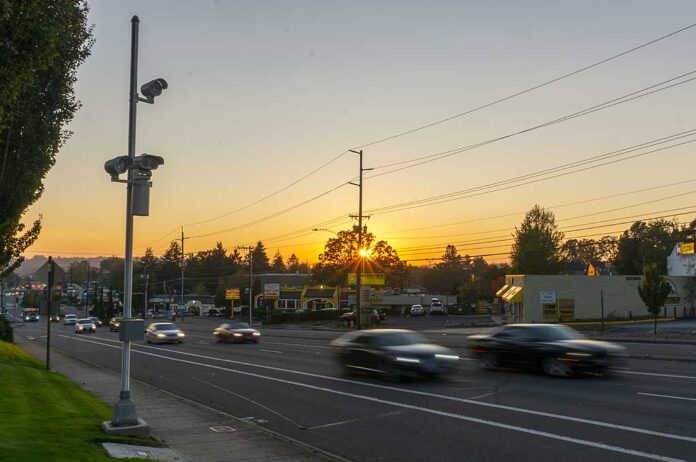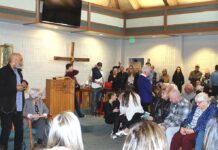If there’s one universal fact of life, it’s that no one likes being stuck in traffic.
Some, however, choose to deal with this by speeding or otherwise engaging in dangerous driving. Tigard is no exception, and police have chosen to utilize an increasingly common tool – automated traffic cameras – to crack down on reckless drivers looking to gain a slight advantage on increasingly crowded streets.
Cameras installed at three key intersections along Highway 99W have been used to monitor compliance with traffic signals since March. In July, use of those cameras was expanded to include speed enforcement at the intersections of 99W and Hall Boulevard and 99W and SW 72nd Avenue; the results to date have been eye opening.
The first month of speed enforcement resulted in over 3,200 violations caught on camera, which drew significant local media attention when the numbers were first publicized a month ago.
“When speed [cameras] went live and we saw those numbers, it was astounding,” said Tigard Police Lt. Neil Charlton, who oversees the department’s traffic enforcement efforts. “All along the line from notifying the chief and notifying the city council, everyone was stunned. We did not expect that.”
The vast majority of the violations recorded – 2,693 – took place at 99W and SW 72nd Avenue, just a few blocks west of Interstate 5. Another 515 violations were caught at 99W and SW Hall Boulevard.
“One individual had four separate citations, and they may not even be aware of it,” Tigard Police Chief Kathy McAlpine told the Tigard City Council at its Sept. 8 meeting.
Of 3,208 violations recorded during July, 2,978 resulted in citations being issued, with the remaining 230 being dismissed.
“What you see predominantly on those is if we can’t identify the driver, or if the registered owner doesn’t match or is obscured,” McAlpine told the Council. “Those abnormalities mean we won’t bring it forward.”
It is even possible for a driver to be issued citations both for speeding and running a red light, due to the dual-function cameras. But that hasn’t happened – yet.
“There is a rule that says if you go through a red light at a high rate of speed, you’ll only be cited for red light, not speed, unless it’s 21 mph over the limit,” McAlpine said. “And no one has gotten that yet.”
The City is contracting with Conduent Transportation out of Maryland to run the traffic camera enforcement program, following years of research that used Oregon Department of Transportation (ODOT) statistics to identify the intersections most at risk for traffic crashes involving vehicles, pedestrians or bicyclists.
The three locations selected intersected Highway 99W at SW 72nd Avenue, SW Hall Blvd and SW Durham Road. Between 2012 and 2016, those three locations were the scene of 42, 72 and 40 traffic crashes, respectively.
“Anecdotally, in my time here, I’ve lost track of how many pedestrian versus vehicle incidents have occurred out there, usually with fatal results for pedestrians,” Charlton said. “It has been something you find all over Pacific Highway, and usually it’s related to speed.”
How the program works is fairly straightforward. Cameras are programmed to take both still photos and videos of red light and speed violations. The images are sent to Conduent, which reviews them for potential errors and sends them back to Tigard Police for follow up and issuing of citations, which can only be done by sworn police officers. When a speeding violation is caught, it must be at least 11 mph over the posted speed limit per Oregon law before a citation may be issued. Potential fines range from $165 to $440, depending on the level of violation.
The results so far, police say, particularly at 99W and SW 72nd, show that the need for the program was, if anything, understated.
“With that kind of volume, it does tax our traffic unit, who are our primary reviewees,” McAlpine said. “They can look at it six hours a day. The downside is they are not out on our streets and in our neighborhoods. We can have over 300 citations a weekend for our officers to review. We’re looking at handling the volume, but you can see the need for monitoring that intersection.”
Tigard Mayor Jason Snider agreed and noted this intersection is also used by many who are simply traveling through the city or to and from their workplace.
“I had a 45-minute meeting related to traffic enforcement with the Lieutenant [Charlton] who is supervising this,” Snider said. “And he and I have our best guesses on this, based on people, and how many people travel that intersection regularly, and that’s not one that’s used [as much] by people who live locally.”
The City Municipal Court hired additional staff before red light enforcement started in March to prepare for an expected increase in citations. And during the spring and summer, it seemed that this was adequate.
“For six months of red light we found it was quite manageable,” Charlton said. “We were not seeing a big jump in numbers.”
That changed in July, and with it came questions from some members of the public about the efficacy of the program. The two main issues, Charlton said, centered on driver privacy, as well as the contention that red-light cameras actually cause more traffic crashes than they prevent.
There have been numerous studies over the past 30 years that have showed the use of cameras can lead to an increase in traffic crashes, and rear-end crashes in particular. These include an Australian Road Research Board study released in 1995, a Virginia Transportation Research Council study released in 2007, a study prepared by the North Carolina A&T State University Urban Transit Institute for the United States Department of Transportation in 2004, an Ontario (Canada) Ministry of Transportation study from 2003 and many more.
But Charlton and other law enforcement officials have also long noted that if rear-end crashes increase with camera enforcement, it also shows that other violations are occurring, including following other drivers too closely.
Other complaints about the cameras have centered on the brightness of flash units used to capture still photographs, five of which are taken with each violation.
Some issues with the system are technical in nature and simply needed some old-fashioned detective work to resolve. One involved an ODOT sign initially blocked the path of the radar unit used to record driver speed at one location. Moving the radar unit to a new masthead quickly solved that problem.
Another complaint focused on cameras continually flashing when drivers are passing through green-lit intersections legally, potentially citing people for a traffic violation they didn’t commit.
But Charlton said the multiple layers of oversight involved in the process make this unlikely.
“That won’t get through the review process,” he said. “Conduent and Tigard Police review the citations before issuing them, and our officers normally reject something because the driver of the vehicle doesn’t match the registered owner, or the license plate maybe doesn’t return properly to the registered owner.”
The photo evidence sent along with each citation, meanwhile, has also allowed Tigard Police to identify at least one stolen vehicle as well as a vehicle connected with a shooting incident in another city.
“As far as implementation, I am happy with it,” Charlton said. “We’ve met with problems along the way, but there’s always going to be issues that are going to pop up.”
Finally, with ongoing public concerns over police practices nationwide, the issue of fairness is an issue when it comes to traffic enforcement. A 2017 Oregon law now requires law enforcement agencies to keep a record of demographics related to traffic stops and other police contacts. In Tigard, the numbers reveal that Black drivers accounted for 337 of the agency’s 6,394 traffic stops between July 1, 2019 and June 30, 2020, the first year such numbers were required. At 2.0 percent of Tigard’s population, this proportion accounts for 5.27 percent of all stops. Meanwhile, white drivers accounted for 75.01 percent of traffic stops, while comprising 73.5 percent of the city’s population. Other groups were stopped at rates more-or-less in line to their proportion of the population.
With cameras, at least, this human element is mostly removed, leading to more consistent enforcement in the long run.
“It’s as fair as we can make the system,” Charlton said. “The camera doesn’t care if you’re a nice person or driving a nice car, or a bad car, or what your economic situation is.”






















